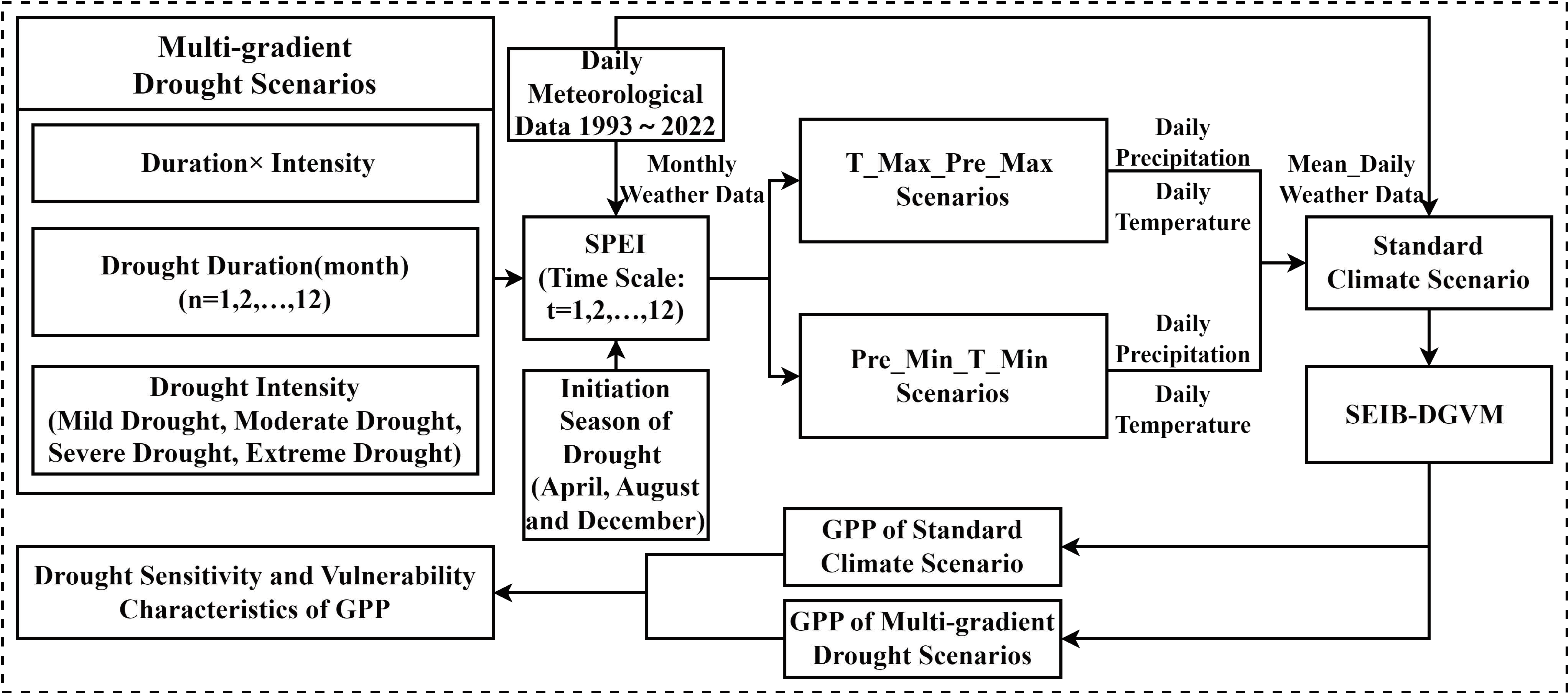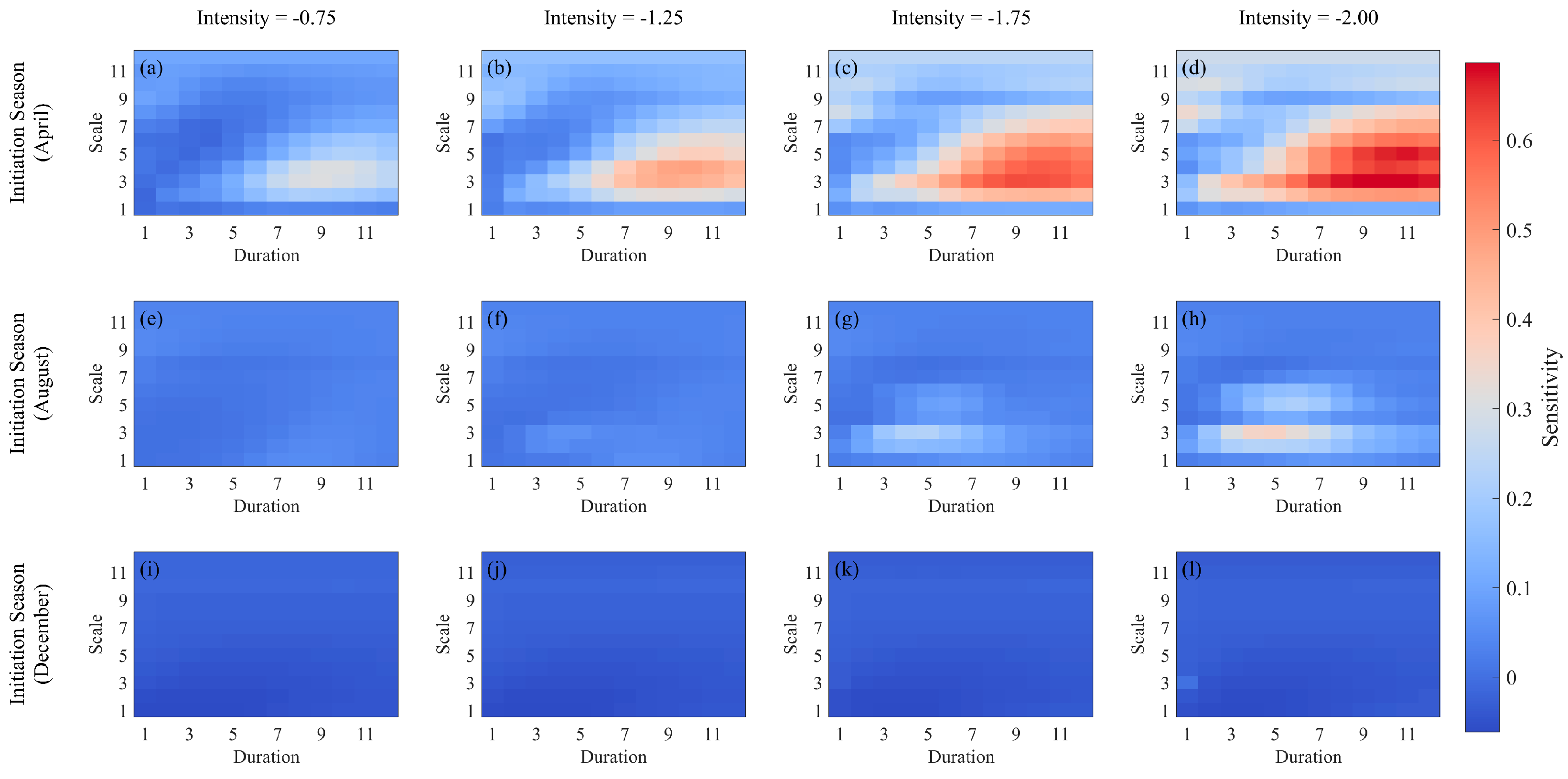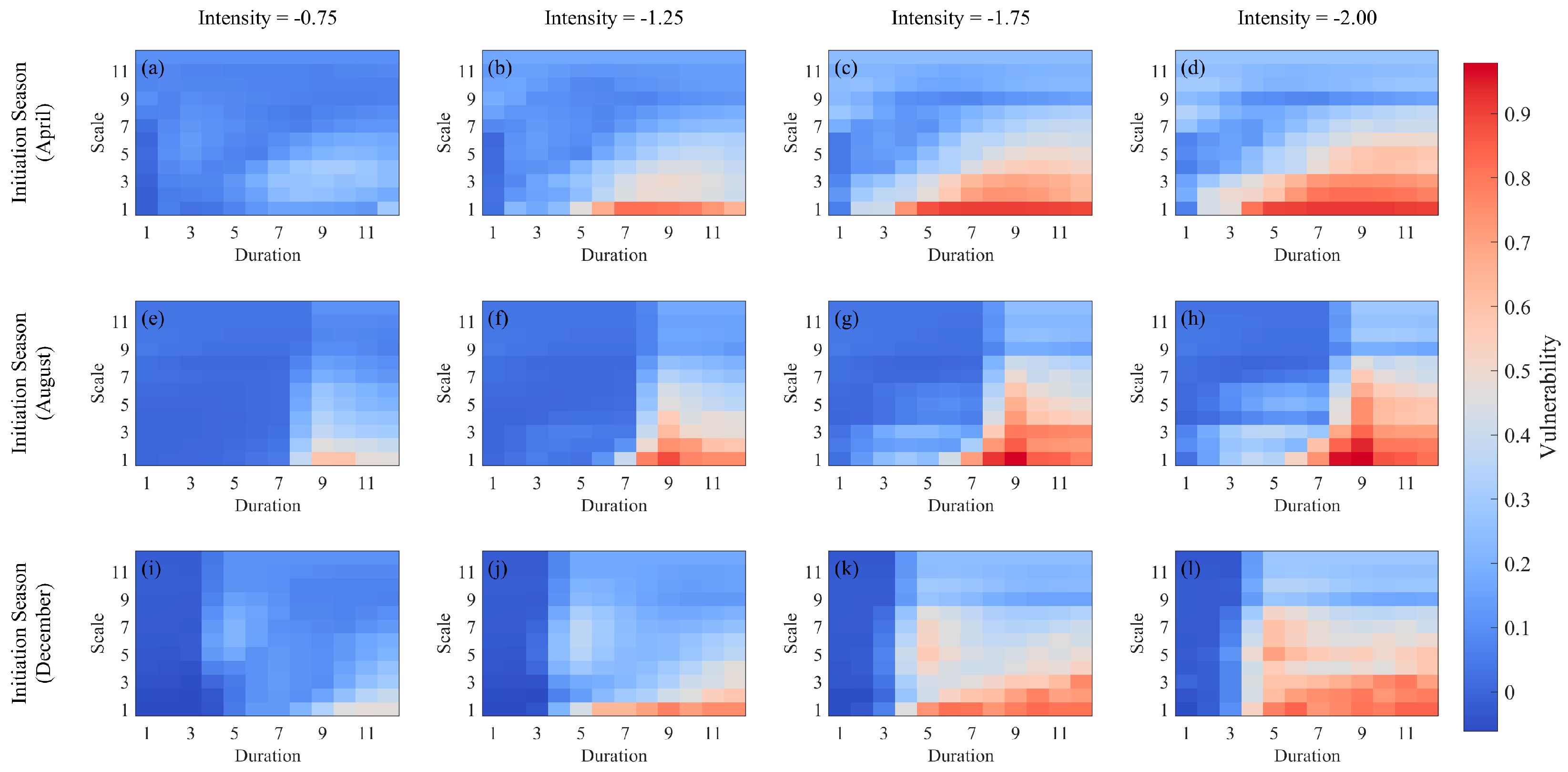Drought Sensitivity and Vulnerability of Rubber Plantation GPP—Insights from Flux Site-Based Simulation
Abstract
1. Introduction
2. Materials and Methods
2.1. Site Description
2.2. Meteorological Data
2.2.1. Site Observation Data
2.2.2. ERA5 Reanalysis Data
2.3. Method
2.3.1. Adaptation of SEIB-DGVM
2.3.2. Drought Identification
2.3.3. Experiment Design for Multi-Gradient Drought Scenarios
- Drought scenarios:
- Model setup:
- Scenario adjustment:
- Data generation:
2.3.4. Sensitivity and Vulnerability
3. Results
3.1. Model Validation
3.2. The Sensitivity and Vulnerability of GPP to Initiation Season of Drought
3.3. The Sensitivity and Vulnerability of GPP to Drought Duration
3.4. The Sensitivity and Vulnerability of GPP to Intensity of Drought
4. Discussion
4.1. The Importance of Evapotranspiration
4.2. Characteristics of Drought
4.3. Characteristics of Rainy or Dry Seasons
5. Conclusions
Supplementary Materials
Author Contributions
Funding
Data Availability Statement
Acknowledgments
Conflicts of Interest
References
- Mishra, A.K.; Singh, V.P. A review of drought concepts. J. Hydrol. 2010, 391, 202–216. [Google Scholar] [CrossRef]
- Fensham, R.J.; Fairfax, R.J.; Ward, D.P. Drought-induced tree death in savanna. Glob. Change Biol. 2009, 15, 380–387. [Google Scholar] [CrossRef]
- Nanzad, L.; Zhang, J.; Tuvdendorj, B.; Yang, S.; Rinzin, S.; Prodhan, F.A.; Sharma, T.P.P. Assessment of drought impact on net primary productivity in the terrestrial ecosystems of Mongolia from 2003 to 2018. Remote Sens. 2021, 13, 2522. [Google Scholar] [CrossRef]
- Xu, C.; McDowell, N.G.; Fisher, R.A.; Wei, L.; Sevanto, S.; Christoffersen, B.O.; Weng, E.; Middleton, R.S. Increasing impacts of extreme droughts on vegetation productivity under climate change. Nat. Clim. Change 2019, 9, 948–953. [Google Scholar] [CrossRef]
- van der Molen, M.K.; Dolman, A.J.; Ciais, P.; Eglin, T.; Gobron, N.; Law, B.E.; Meir, P.; Peters, W.; Phillips, O.L.; Reichstein, M.; et al. Drought and ecosystem carbon cycling. Agric. For. Meteorol. 2011, 151, 765–773. [Google Scholar] [CrossRef]
- Chiang, F.; Mazdiyasni, O.; AghaKouchak, A. Evidence of anthropogenic impacts on global drought frequency, duration, and intensity. Nat. Commun. 2021, 12, 2754. [Google Scholar] [CrossRef] [PubMed]
- Murray, V.; Ebi, K.L. IPCC special report on managing the risks of extreme events and disasters to advance climate change adaptation (SREX). J. Epidemiol. Community Health 2012, 66, 759–760. [Google Scholar] [CrossRef]
- Masson-Delmotte, V.P.; Zhai, P.; Pirani, S.L.; Connors, C.; Péan, S.; Berger, N.; Caud, Y.; Chen, L.; Goldfarb, M.I.; Gomis, M.; et al. IPCC, 2021: Summary for policymakers. In Climate Change 2021: The Physical Science Basis; Contribution of Working Group I to the Sixth Assessment Report of the Intergovernmental Panel on Climate Change; Cambridge University Press: Cambridge, UK; New York, NY, USA, 2021. [Google Scholar]
- Nemani, R.R.; Keeling, C.D.; Hashimoto, H.; Jolly, W.M.; Piper, S.C.; Tucker, C.J.; Myneni, R.B.; Running, S.W. Climate-driven increases in global terrestrial net primary production from 1982 to 1999. Science 2003, 300, 1560–1563. [Google Scholar] [CrossRef]
- Xu, X.; Piao, S.; Wang, X.; Chen, A.; Ciais, P.; Myneni, R.B. Spatio-temporal patterns of the area experiencing negative vegetation growth anomalies in China over the last three decades. Environ. Res. Lett. 2012, 7, 035701. [Google Scholar] [CrossRef]
- Aragão LE, O.; Malhi, Y.; Roman-Cuesta, R.M.; Saatchi, S.; Anderson, L.O.; Shimabukuro, Y.E. Spatial patterns and fire response of recent Amazonian droughts. Geophys. Res. Lett. 2007, 34. [Google Scholar] [CrossRef]
- Lewis, S.L.; Brando, P.M.; Phillips, O.L.; Van Der Heijden, G.M.; Nepstad, D. The 2010 amazon drought. Science 2011, 331, 554. [Google Scholar] [CrossRef] [PubMed]
- Brienen, R.J.; Phillips, O.L.; Feldpausch, T.R.; Gloor, E.; Baker, T.R.; Lloyd, J.; Lopez-Gonzalez, G.; Monteagudo-Mendoza, A.; Malhi, Y.; Lewis, S.L.; et al. Long-term decline of the Amazon carbon sink. Nature 2015, 519, 344–348. [Google Scholar] [CrossRef] [PubMed]
- Baccini, A.; Walker, W.; Carvalho, L.; Farina, M.; Sulla-Menashe, D.; Houghton, R.A. Tropical forests are a net carbon source based on aboveground measurements of gain and loss. Science 2017, 358, 230–234. [Google Scholar] [CrossRef] [PubMed]
- Lu, J.; Yan, F. The Divergent Resistance and Resilience of Forest and Grassland Ecosystems to Extreme Summer Drought in Carbon Sequestration. Land 2023, 12, 1672. [Google Scholar] [CrossRef]
- Saleska, S.R.; Didan, K.; Huete, A.R.; Da Rocha, H.R. Amazon forests green-up during 2005 drought. Science 2007, 318, 612. [Google Scholar] [CrossRef] [PubMed]
- Gatti, L.V.; Gloor, M.; Miller, J.B.; Doughty, C.E.; Malhi, Y.; Domingues, L.G.; Basso, L.S.; Martinewski, A.; Correia, C.S.C.; Borges, V.F.; et al. Drought sensitivity of Amazonian carbon balance revealed by atmospheric measurements. Nature 2014, 506, 76–80. [Google Scholar] [CrossRef] [PubMed]
- Phillips, O.L.; Aragão, L.E.; Lewis, S.L.; Fisher, J.B.; Lloyd, J.; López-González, G.; Malhi, Y.; Monteagudo, A.; Peacock, J.; Quesada, C.A.; et al. Drought sensitivity of the Amazon rainforest. Science 2009, 323, 1344–1347. [Google Scholar] [CrossRef]
- Saleska, S.R.; Wu, J.; Guan, K.; Araujo, A.C.; Huete, A.; Nobre, A.D.; Restrepo-Coupe, N. Dry-season greening of Amazon forests. Nature 2016, 531, E4–E5. [Google Scholar] [CrossRef]
- Ju, J.; Roy, D.P. The availability of cloud-free Landsat ETM+ data over the conterminous United States and globally. Remote Sens. Environ. 2008, 112, 1196–1211. [Google Scholar] [CrossRef]
- Gao, F.; Zhang, S.; Yu, R.; Zhao, Y.; Chen, Y.; Zhang, Y. Agricultural Drought Risk Assessment Based on a Comprehensive Model Using Geospatial Techniques in Songnen Plain, China. Land 2023, 12, 1184. [Google Scholar] [CrossRef]
- Liu, J.; Wu, Z.; Yang, S.; Yang, C. Sensitivity Analysis of Biome-BGC for Gross Primary Production of a Rubber Plantation Ecosystem: A Case Study of Hainan Island, China. Int. J. Environ. Res. Public Health 2022, 19, 14068. [Google Scholar] [CrossRef]
- Giambelluca, T.W.; Mudd, R.G.; Liu, W.; Ziegler, A.D.; Kobayashi, N.; Kumagai, T.O.; Miyazawa, Y.; Lim, T.K.; Huang, M.; Fox, J. Evapotranspiration of rubber (Hevea brasiliensis) cultivated at two plantation sites in S outheast A sia. Water Resour. Res. 2016, 52, 660–679. [Google Scholar] [CrossRef]
- Wang, X.; Blanken, P.D.; Kasemsap, P.; Petchprayoon, P.; Thaler, P.; Nouvellon, Y.; Gay, F.; Chidthaisong, A.; Sanwangsri, M.; Chayawat, C.; et al. Carbon and water cycling in two rubber plantations and a natural forest in Mainland Southeast Asia. J. Geophys. Res. Biogeosci. 2022, 127, e2022JG006840. [Google Scholar] [CrossRef]
- Ali, A.A.; Fan, Y.; Corre, M.D.; Kotowska, M.M.; Preuss-Hassler, E.; Cahyo, A.N.; Moyano, F.E.; Stiegler, C.; Röll, A.; Meijide, A.; et al. Implementing a New Rubber Plant Functional Type in the Community Land Model (CLM5) Improves Accuracy of Carbon and Water Flux Estimation. Land 2022, 11, 183. [Google Scholar] [CrossRef]
- Grace, J. Understanding and managing the global carbon cycle. J. Ecol. 2004, 92, 189–202. [Google Scholar] [CrossRef]
- Pan, Y.; Birdsey, R.A.; Fang, J.; Houghton, R.; Kauppi, P.E.; Kurz, W.A.; Phillips, O.L.; Shvidenko, A.; Lewis, S.L.; Canadell, J.G.; et al. A large and persistent carbon sink in the world’s forests. Science 2011, 333, 988–993. [Google Scholar] [CrossRef]
- Nottingham, A.T.; Meir, P.; Velasquez, E.; Turner, B.L. Soil carbon loss by experimental warming in a tropical forest. Nature 2020, 584, 234–237. [Google Scholar] [CrossRef]
- Townsend, A.R.; Cleveland, C.C.; Houlton, B.Z.; Alden, C.B.; White, J.W. Multi-element regulation of the tropical forest carbon cycle. Front. Ecol. Environ. 2011, 9, 9–17. [Google Scholar] [CrossRef]
- Lan, G.; Wu, Z.; Chen, B.; Xie, G. Species diversity in a naturally managed rubber plantation in Hainan Island, South China. Trop. Conserv. Sci. 2017, 10, 1940082917712427. [Google Scholar] [CrossRef]
- Wu, Z.; Guan, L.; Chen, B.; Yang, C.; Lan, G.; Xie, G.; Zhou, Z. Components of soil respiration and its monthly dynamics in rubber plantation ecosystems. In Proceedings of the 2013 Fourth International Conference on Digital Manufacturing & Automation, Qingdao, China, 29–30 June 2013; IEEE: New York, NY, USA, 2013; pp. 361–369. [Google Scholar]
- Yang, S.; Wu, Z.; Yang, C.; Song, B.; Liu, J.; Chen, B.; Lan, G.; Sun, R.; Zhang, J. Responses of carbon exchange characteristics to meteorological factors, phenology, and extreme events in a rubber plantation of Danzhou, Hainan: Evidence based on multi-year data. Front. Ecol. Evol. 2023, 11, 1194147. [Google Scholar] [CrossRef]
- Chandrashekar, T.R.; Marattukalam, J.G.; Nazeer, M.A. Growth reaction of Hevea brasiliensis to heat and drought stress under dry subhumid climatic conditions. Indian J. Nat. Rubber Res. 1996, 9, 1996. [Google Scholar]
- Kumagai, T.O.; Mudd, R.G.; Miyazawa, Y.; Liu, W.; Giambelluca, T.W.; Kobayashi, N.; Lim, T.K.; Jomura, M.; Matsumoto, K.; Huang, M. Simulation of canopy CO2/H2O fluxes for a rubber (Hevea brasiliensis) plantation in central Cambodia: The effect of the regular spacing of planted trees. Ecol. Model. 2013, 265, 124–135. [Google Scholar] [CrossRef]
- Yang, X.; Blagodatsky, S.; Marohn, C.; Liu, H.; Golbon, R.; Xu, J.; Cadisch, G. Climbing the mountain fast but smart: Modelling rubber tree growth and latex yield under climate change. For. Ecol. Manag. 2019, 439, 55–69. [Google Scholar] [CrossRef]
- Nizami, S.M.; Yiping, Z.; Liqing, S.; Zhao, W.; Zhang, X. Managing carbon sinks in rubber (Hevea brasilensis) plantation by changing rotation length in SW China. PLoS ONE 2014, 9, e115234. [Google Scholar] [CrossRef]
- Cui, W.; Xiong, Q.; Zheng, Y.; Zhao, J.; Nie, T.; Wu, L.; Sun, Z. A study on the vulnerability of the gross primary production of rubber plantations to regional short-term flash drought over Hainan Island. Forests 2022, 13, 893. [Google Scholar] [CrossRef]
- Sopharat, J.; Sdoodee, S.; Tanavud, C.; Gay, F.; Thaler, P. A simple water balance model of rubber tree plantations under different evaporative demand regimes. Adv. Mater. Res. 2014, 844, 20–23. [Google Scholar] [CrossRef]
- Wang, L.F. Physiological and molecular responses to drought stress in rubber tree (Hevea brasiliensis Muell. Arg.). Plant Physiol. Biochem. 2014, 83, 243–249. [Google Scholar] [CrossRef]
- Tong, S.; Wang, W.; Chen, J.; Xu, C.Y.; Sato, H.; Wang, G. Impact of changes in climate and CO2 on the carbon storage potential of vegetation under limited water availability using SEIB-DGVM version 3.02. Geosci. Model Dev. 2022, 15, 7075–7098. [Google Scholar] [CrossRef]
- Arakida, H.; Kotsuki, S.; Otsuka, S.; Sawada, Y.; Miyoshi, T. Regional-scale data assimilation with the Spatially Explicit Individual-based Dynamic Global Vegetation Model (SEIB-DGVM) over Siberia. Prog. Earth Planet. Sci. 2021, 8, 52. [Google Scholar] [CrossRef]
- Sato, H. Simulation of the vegetation structure and function in a Malaysian tropical rain forest using the individual-based dynamic vegetation model SEIB-DGVM. For. Ecol. Manag. 2009, 257, 2277–2286. [Google Scholar] [CrossRef]
- Wu, Z.; Xie, G.; Chen, B.; Yang, C.; Zhou, Z.; Tao, Z. Fluxes footprint and source area of rubber plantation. Agric. Sci. Technol.-Hunan 2011, 12, 1937–1942. [Google Scholar]
- Sato, H.; Itoh, A.; Kohyama, T. SEIB–DGVM: A new Dynamic Global Vegetation Model using a spatially explicit individual-based approach. Ecol. Model. 2007, 200, 279–307. [Google Scholar] [CrossRef]
- Vicente-Serrano, S.M.; Beguería, S.; López-Moreno, J.I. A multiscalar drought index sensitive to global warming: The standardized precipitation evapotranspiration index. J. Clim. 2010, 23, 1696–1718. [Google Scholar] [CrossRef]
- Crausbay, S.D.; Ramirez, A.R.; Carter, S.L.; Cross, M.S.; Hall, K.R.; Bathke, D.J.; Betancourt, J.L.; Colt, S.; Cravens, A.E.; Dalton, M.S.; et al. Defining ecological drought for the twenty-first century. Bull. Am. Meteorol. Soc. 2017, 98, 2543–2550. [Google Scholar] [CrossRef]
- Dong, C.; MacDonald, G.; Okin, G.S.; Gillespie, T.W. Quantifying drought sensitivity of Mediterranean climate vegetation to recent warming: A case study in Southern California. Remote Sens. 2019, 11, 2902. [Google Scholar] [CrossRef]
- Meza, I.; Hagenlocher, M.; Naumann, G.; Vogt, J.; Frischen, J. Drought Vulnerability Indicators for Global-Scale Drought Risk Assessments; Publications Office of the European Union: Luxembourg, 2019. [Google Scholar]
- Xiong, Q.; Sun, Z.; Cui, W.; Lei, J.; Fu, X.; Wu, L. A Study on Sensitivities of Tropical Forest GPP Responding to the Characteristics of Drought—A Case Study in Xishuangbanna, China. Water 2022, 14, 157. [Google Scholar] [CrossRef]
- Chang, T.J.; Kleopa, X.A. A proposed method for drought monitoring 1. JAWRA J. Am. Water Resour. Assoc. 1991, 27, 275–281. [Google Scholar] [CrossRef]
- Heim, R.R., Jr. A review of twentieth-century drought indices used in the United States. Bull. Am. Meteorol. Soc. 2002, 83, 1149–1166. [Google Scholar] [CrossRef]
- Hu, Q.; Willson, G.D. Effects of temperature anomalies on the Palmer Drought Severity Index in the central United States. Int. J. Climatol. A J. R. Meteorol. Soc. 2000, 20, 1899–1911. [Google Scholar] [CrossRef]
- Abramopoulos, F.; Rosenzweig, C.; Choudhury, B. Improved ground hydrology calculations for global climate models (GCMs): Soil water movement and evapotranspiration. J. Clim. 1988, 1, 921–941. [Google Scholar] [CrossRef]
- Rebetez, M.; Mayer, H.; Dupont, O.; Schindler, D.; Gartner, K.; Kropp, J.P.; Menzel, A. Heat and drought 2003 in Europe: A climate synthesis. Ann. For. Sci. 2006, 63, 569–577. [Google Scholar] [CrossRef]
- Munson, S.M.; Bradford, J.B.; Hultine, K.R. An integrative ecological drought framework to span plant stress to ecosystem transformation. Ecosystems 2021, 24, 739–754. [Google Scholar] [CrossRef]
- Doughty, C.E.; Malhi, Y.; Araujo-Murakami, A.; Metcalfe, D.B.; Silva-Espejo, J.E.; Arroyo, L.; Heredia, J.P.; Pardo-Toledo, E.; Mendizabal, L.M.; Rojas-Landivar, V.D.; et al. Allocation trade-offs dominate the response of tropical forest growth to seasonal and interannual drought. Ecology 2014, 95, 2192–2201. [Google Scholar] [CrossRef]
- Yang, S.; Zhang, J.; Han, J.; Wang, J.; Zhang, S.; Bai, Y.; Cao, D.; Xun, L.; Zheng, M.; Chen, H.; et al. Evaluating global ecosystem water use efficiency response to drought based on multi-model analysis. Sci. Total Environ. 2021, 778, 146356. [Google Scholar] [CrossRef]
- Dubovyk, O.; Landmann, T.; Dietz, A.; Menz, G. Quantifying the impacts of environmental factors on vegetation dynamics over climatic and management gradients of Central Asia. Remote Sens. 2016, 8, 600. [Google Scholar] [CrossRef]
- Schärer, M.L.; Lüscher, A.; Kahmen, A. Post-drought compensatory growth in perennial grasslands is determined by legacy effects of the soil and not by plants. New Phytol. 2023, 240, 2265–2275. [Google Scholar] [CrossRef]
- Zhang, Y.; Liu, G.; Xu, S.; Dai, J.; Li, W.; Li, Z.; Zhang, D.; Cui, Z.; Li, C.; Dong, H. Nitric oxide reduces the yield loss of waterlogged cotton by enhancing post-stress compensatory growth. Field Crops Res. 2022, 283, 108524. [Google Scholar] [CrossRef]
- Shi, F.; Wu, X.; Li, X.; Ciais, P.; Liu, H.; Yue, C.; Yang, Y.; Zhang, S.; Peng, S.; Yin, Y.; et al. Seasonal compensation implied no weakening of the land carbon sink in the Northern Hemisphere under the 2015/2016 El Niño. Sci. China Earth Sci. 2024, 67, 281–294. [Google Scholar] [CrossRef]
- Gupta, A.; Rico-Medina, A.; Caño-Delgado, A.I. The physiology of plant responses to drought. Science 2020, 368, 266–269. [Google Scholar] [CrossRef]
- Wang, Y.; Hollingsworth, P.M.; Zhai, D.; West, C.D.; Green, J.M.; Chen, H.; Hurni, K.; Su, Y.; Warren-Thomas, E.; Xu, J.; et al. High-resolution maps show that rubber causes substantial deforestation. Nature 2023, 623, 340–346. [Google Scholar] [CrossRef]
- Matusick, G.; Ruthrof, K.X.; Kala, J.; Brouwers, N.C.; Breshears, D.D.; Hardy, G.E.S.J. Chronic historical drought legacy exacerbates tree mortality and crown dieback during acute heatwave-compounded drought. Environ. Res. Lett. 2018, 13, 095002. [Google Scholar] [CrossRef]
- Tschumi, E.; Lienert, S.; van der Wiel, K.; Joos, F.; Zscheischler, J. The effects of varying drought-heat signatures on terrestrial carbon dynamics and vegetation composition. Biogeosci. Discuss. 2021, 2021, 1–19. [Google Scholar] [CrossRef]







Disclaimer/Publisher’s Note: The statements, opinions and data contained in all publications are solely those of the individual author(s) and contributor(s) and not of MDPI and/or the editor(s). MDPI and/or the editor(s) disclaim responsibility for any injury to people or property resulting from any ideas, methods, instructions or products referred to in the content. |
© 2024 by the authors. Licensee MDPI, Basel, Switzerland. This article is an open access article distributed under the terms and conditions of the Creative Commons Attribution (CC BY) license (https://creativecommons.org/licenses/by/4.0/).
Share and Cite
Zhang, R.; E, X.; Ma, Z.; An, Y.; Bao, Q.; Wu, Z.; Wu, L.; Sun, Z. Drought Sensitivity and Vulnerability of Rubber Plantation GPP—Insights from Flux Site-Based Simulation. Land 2024, 13, 745. https://doi.org/10.3390/land13060745
Zhang R, E X, Ma Z, An Y, Bao Q, Wu Z, Wu L, Sun Z. Drought Sensitivity and Vulnerability of Rubber Plantation GPP—Insights from Flux Site-Based Simulation. Land. 2024; 13(6):745. https://doi.org/10.3390/land13060745
Chicago/Turabian StyleZhang, Runqing, Xiaoyu E, Zhencheng Ma, Yinghe An, Qinggele Bao, Zhixiang Wu, Lan Wu, and Zhongyi Sun. 2024. "Drought Sensitivity and Vulnerability of Rubber Plantation GPP—Insights from Flux Site-Based Simulation" Land 13, no. 6: 745. https://doi.org/10.3390/land13060745
APA StyleZhang, R., E, X., Ma, Z., An, Y., Bao, Q., Wu, Z., Wu, L., & Sun, Z. (2024). Drought Sensitivity and Vulnerability of Rubber Plantation GPP—Insights from Flux Site-Based Simulation. Land, 13(6), 745. https://doi.org/10.3390/land13060745







